Recognizing the Biosafety Levels
This Quick Learn Lesson will take approximately 15 minutes to complete.
When you have completed this lesson, you will be able to recognize characteristics of the four biological safety levels.
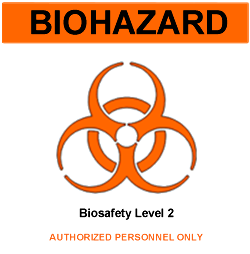
Introduction
Suppose you are a laboratory microbiologist working with a potentially harmful microbe. Precautions must be taken in the laboratory to make sure you and others are not infected.
- Where in the lab would you complete your work?
- What protective equipment and practices would you use?
- How would you contain the microbe to limit contamination or accidental infection?
These are just a few of the questions that can be answered through an understanding of biosafety and the four biosafety levels (BSLs).
Microbe
Microbes are organisms, such as bacteria and viruses that are too small to be seen by the naked eye.
Biosafety and Biosafety Levels
What is Biosafety?
Biosafety is the application of safety precautions that reduce a laboratorian’s risk of exposure to a potentially infectious microbe and limit contamination of the work environment and, ultimately, the community.
What are Biosafety Levels (BSLs)?
There are four biosafety levels. Each level has specific controls for containment of microbes and biological agents. The primary risks that determine levels of containment are infectivity, severity of disease, transmissibility, and the nature of the work conducted. Origin of the microbe, or the agent in question, and the route of exposure are also important.
Each biosafety level has its own specific containment controls that are required for the following:
- Laboratory practices
- Safety equipment
- Facility construction
Route of Exposure
Route of exposure is the way a microbe gains access to a living organism. There are four main routes of exposure
- Percutaneous, though broken or damaged skin
- Inhalation
- Mucous membranes of the eyes, nose, and mouth
- Ingestion
BSLs, continued
The biosafety levels range from BSL-1 to BSL-4. Each biosafety level builds on the controls of the level before it. Every microbiology laboratory, regardless of biosafety level, follows standard microbiological practices.

You will learn about each level on the following screens.
Standard Microbiological Practices
Standard microbiological practices are those practices that are common to all laboratories. These practices may include
- Not eating, drinking, or applying cosmetics in the lab
- Washing hands after working with infectious materials and before leaving the lab
- Routinely decontaminating work surfaces
BSL-1

If you work in a lab that is designated a BSL-1, the microbes there are not known to consistently cause disease in healthy adults and present minimal potential hazard to laboratorians and the environment. An example of a microbe that is typically worked with at a BSL-1 is a nonpathogenic strain of E. coli.
Specific considerations for a BSL-1 laboratory include the following:
Laboratory practices
- Standard microbiological practices are followed.
- Work can be performed on an open lab bench or table
 .
.
Safety equipment
- Personal protective equipment
 , (lab coats, gloves, eye protection) are worn as needed.
, (lab coats, gloves, eye protection) are worn as needed.
Facility construction
- A sink must be available for hand washing.
- The lab should have doors to separate the working space with the rest of the facility.
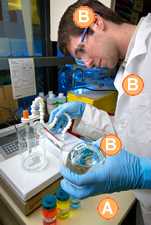
Nonpathogenic
A nonpathogenic microbe is one that is not capable of causing disease.
Personal Protective Equipment (PPE)
Equipment worn to minimize exposure to a variety of hazards. Examples of PPE include laboratory coats, gowns, gloves, eye protection, face shields, shoe covers, and respirators.
BSL-2

BSL-2 builds upon BSL-1. If you work in a lab that is designated a BSL-2, the microbes there pose moderate hazards to laboratorians and the environment. The microbes are typically indigenous and associated with diseases of varying severity. An example of a microbe that is typically worked with at a BSL-2 laboratory is Staphylococcus aureus.
Indigenous
Indigenous microbes are those that are commonly found in the geographic region.
BSL-2, continued
In addition to BSL-1 considerations, BSL-2 laboratories have the following containment requirements:
Laboratory practices
- Access to the laboratory is restricted when work is being conducted.
Safety equipment
- Appropriate personal protective equipment (PPE)
 is worn, including lab coats and gloves. Eye protection and face shields can also be worn, as needed.
is worn, including lab coats and gloves. Eye protection and face shields can also be worn, as needed. - All procedures that can cause infection from aerosols or splashes are performed within a biological safety cabinet (BSC)
 .
. - An autoclave or an alternative method of decontamination is available for proper disposals.
Facility construction
- The laboratory has self-closing doors.
- A sink and eyewash are readily available.
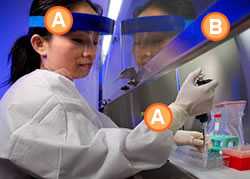
Autoclave
Equipment used to decontaminate biological hazardous waste or to sterilize equipment and supplies by subjecting them to high pressure and saturated steam
Biological Safety Cabinet (BSC)
A ventilated cabinet designed to provide personnel, product, and environmental protection when appropriate practices and procedures are followed
Eyewash
An apparatus used to physically wash the eyes if they are contaminated by infectious microbes, foreign materials, or other substances
Face Shields
A protective device commonly used to shield the wearer's face and eyes from hazards such as the splashing, spraying, or splattering of potentially harmful infectious materials
BSL-3

BSL-3 builds upon the containment requirements of BSL-2. If you work in a lab that is designated BSL-3, the microbes there can be either indigenous or exotic, and they can cause serious or potentially lethal disease through respiratory transmission. Respiratory transmission is the inhalation route of exposure. One example of a microbe that is typically worked with in a BSL-3 laboratory is Mycobacterium tuberculosis, the bacteria that causes tuberculosis.
BSL-3, continued
In addition to BSL-2 considerations, BSL-3 laboratories have the following containment requirements:
Laboratory practices
- Laboratorians are under medical surveillance and might receive immunizations for microbes they work with.
- Access to the laboratory is restricted and controlled at all times.
Safety equipment
- Appropriate PPE must be worn, and respirators might be required
 .
. - All work with microbes must be performed within an appropriate BSC
 .
.
Facility construction
- A hands-free sink and eyewash are available near the exit.
- Exhaust air cannot be recirculated, and the laboratory must have sustained directional airflow by drawing air into the laboratory from clean areas towards potentially contaminated areas.
- Entrance to the lab is through two sets of self-closing and locking doors
 .
.

Respirator
A protective device that covers the nose and mouth or the entire face or head. Lab respirators filter out infectious or harmful particles; some supply the wearer with HEPA-filtered air. Appropriate respirators are chosen based on the type of work being performed.
BSL-4

BSL-4 builds upon the containment requirements of BSL-3 and is the highest level of biological safety. There are a small number of BSL-4 labs in the United States and around the world. The microbes in a BSL-4 lab are dangerous and exotic, posing a high risk of aerosol-transmitted infections. Infections caused by these microbes are frequently fatal and without treatment or vaccines. Two examples of microbes worked with in a BSL-4 laboratory include Ebola and Marburg viruses.
BSL-4, Continued
In addition to BSL-3 considerations, BSL-4 laboratories have the following containment requirements:
Laboratory practices
- Change clothing before entering.
- Shower upon exiting.
- Decontaminate all materials before exiting.
Safety equipment
- All work with the microbe must be performed within an appropriate Class III BSC , or by wearing a full body, air-supplied, positive pressure
 suit.
suit.
Facility construction
- The laboratory is in a separate building or in an isolated and restricted zone of the building.
- The laboratory has dedicated supply and exhaust air, as well as vacuum lines and decontamination systems.
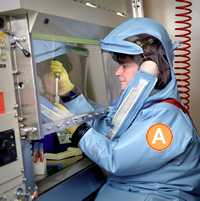
Class III BSC
A gas-tight sealed container that is designed to allow for the manipulation of objects, hazardous substances, or infectious disease agents. Class III BSCs have a HEPA filtered air supply and double HEPA filtered exhaust. They provide the ultimate protection for personnel, product, and the environment.
Positive Pressure Protective Suit
Highly specialized, totally encapsulating industrial protection garments worn only within special biocontainment or maximum containment (BSL-4) laboratory facilities. The positive pressure in the suit will force air to flow out if the suit is damaged.
Your Turn: Exercises
Now that you have learned about the four biosafety levels, it's your turn to identify the correct BSL in the examples on the following screens. Select the Next icon to begin.
Your turn: Exercise 1
Select the biosafety level described by the conditions of the following example. Levels are listed below.
A microbiology graduate student is working on a project under the following conditions:
- Work is conducted on a standard laboratory table or bench.
- A nonpathogenic laboratory strain of E. coli is being used.
- Minimal PPE, such as a lab coat, gloves, and eye protection might be worn but are not necessary.
Exercise 1: Correct
That is correct!
This example suggests a BSL-1 laboratory where there is minimal risk of infection. A nonpathogenic strain of E. coli is being used, and work is conducted on a standard laboratory bench. Special PPE and facility construction are not necessary.
Exercise 1: Incorrect
That is incorrect!
The correct answer is BSL-1.
This example suggests a BSL-1 laboratory where there is minimal risk of infection. A nonpathogenic strain of E. coli is being used, and work is conducted on a standard laboratory bench. Special PPE and facility construction are not necessary.
Exercise 1: Incorrect
That is incorrect!
The correct answer is BSL-1.
This example suggests a BSL-1 laboratory where there is minimal risk of infection. A nonpathogenic strain of E. coli is being used, and work is conducted on a standard laboratory bench. Special PPE and facility construction are not necessary.
Exercise 1: Incorrect
That is incorrect!
The correct answer is BSL-1.
This example suggests a BSL-1 laboratory where there is minimal risk of infection. A nonpathogenic strain of E. coli is being used, and work is conducted on a standard laboratory bench. Special PPE and facility construction are not necessary.
Your turn: Exercise 2
Select the biosafety level shown in the photo below. Click on the photo for a larger image.
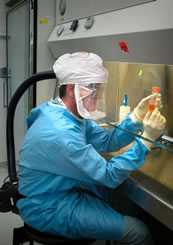

Exercise 2: Incorrect
That is incorrect!
The correct answer is BSL-3.
This photograph suggests a BSL-3 laboratory. The laboratorian is working within a BSC and is wearing a powered air purifying respirator, gloves, and a solid-front gown.

Exercise 2: Incorrect
That is incorrect!
The correct answer is BSL-3.
This photograph suggests a BSL-3 laboratory. The laboratorian is working within a BSC and is wearing a powered air purifying respirator, gloves, and a solid-front gown.

Exercise 2: Correct
That is correct!
This photograph suggests a BSL-3 laboratory. The laboratorian is working within a BSC and is wearing a powered air purifying respirator, gloves, and a solid-front gown.

Exercise 2: Incorrect
That is incorrect!
The correct answer is BSL-3.
This photograph suggests a BSL-3 laboratory. The laboratorian is working within a BSC and is wearing a powered air purifying respirator, gloves, and a solid-front gown.

Your turn: Exercise 3
Select the biosafety level described by the conditions of the following example. Levels are listed below.
- Work is conducted on a standard laboratory bench in a contained area.
- PPE, including a lab coat, gloves, and eye protection are being used to reduce accidental infection.
Exercise 3: Incorrect
That is incorrect!
The correct answer is BSL-2.
This scenario suggests a BSL-2 laboratory. The laboratorian is working with a pathogenic strain of Staphylococcus, which poses moderate risk of infection. Work is conducted on a standard laboratory bench within a contained area, and the laboratorian is wearing appropriate PPE to reduce the risk of accidental infection.
Exercise 3: Correct
That is correct!
This scenario suggests a BSL-2 laboratory. The laboratorian is working with a pathogenic strain of Staphylococcus, which poses moderate risk of infection. Work is conducted on a standard laboratory bench within a contained area, and the laboratorian is wearing appropriate PPE to reduce the risk of accidental infection.
Exercise 3: Incorrect
That is incorrect!
The correct answer is BSL-2.
This scenario suggests a BSL-2 laboratory. The laboratorian is working with a pathogenic strain of Staphylococcus, which poses moderate risk of infection. Work is conducted on a standard laboratory bench within a contained area, and the laboratorian is wearing appropriate PPE to reduce the risk of accidental infection.
Exercise 3: Incorrect
That is incorrect!
The correct answer is BSL-2.
This scenario suggests a BSL-2 laboratory. The laboratorian is working with a pathogenic strain of Staphylococcus, which poses moderate risk of infection. Work is conducted on a standard laboratory bench within a contained area, and the laboratorian is wearing appropriate PPE to reduce the risk of accidental infection.
Your turn: Exercise 4
Select the biosafety level shown in the following photograph below. Click on the photo for a larger image.
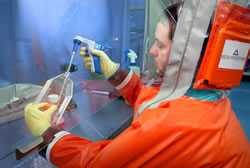

Exercise 4: Incorrect
That is incorrect!
The correct answer is BSL-4.
This image suggests a BSL-4 laboratory. The scientist is working within a BSC. He is wearing a full-body, air-supplied, positive pressure protective suit.

Exercise 4: Incorrect
That is incorrect!
The correct answer is BSL-4.
This image suggests a BSL-4 laboratory. The scientist is working within a BSC. He is wearing a full-body, air-supplied, positive pressure protective suit.

Exercise 4: Incorrect
That is incorrect!
The correct answer is BSL-4.
This image suggests a BSL-4 laboratory. The scientist is working within a BSC. He is wearing a full-body, air-supplied, positive pressure protective suit.

Exercise 4: Correct
That is correct!
This image suggests a BSL-4 laboratory. The scientist is working within a BSC. He is wearing a full-body, air-supplied, positive pressure protective suit.

Summary
Congratulations!
You should now be able to recognize characteristics of the four biological safety levels. If you would like additional information or resources on the topic of biosafety, select the Next icon. To view other Quick Learn Lessons, visit CDC Learning Connection.
Resources
For more information on biosafety and laboratory practice, review the following web resources:
- Biosafety in Microbiological and Biomedical Laboratories (5th Edition)
- Biosafety — Centers for Disease Control and Prevention
- Respirator Fact Sheet

